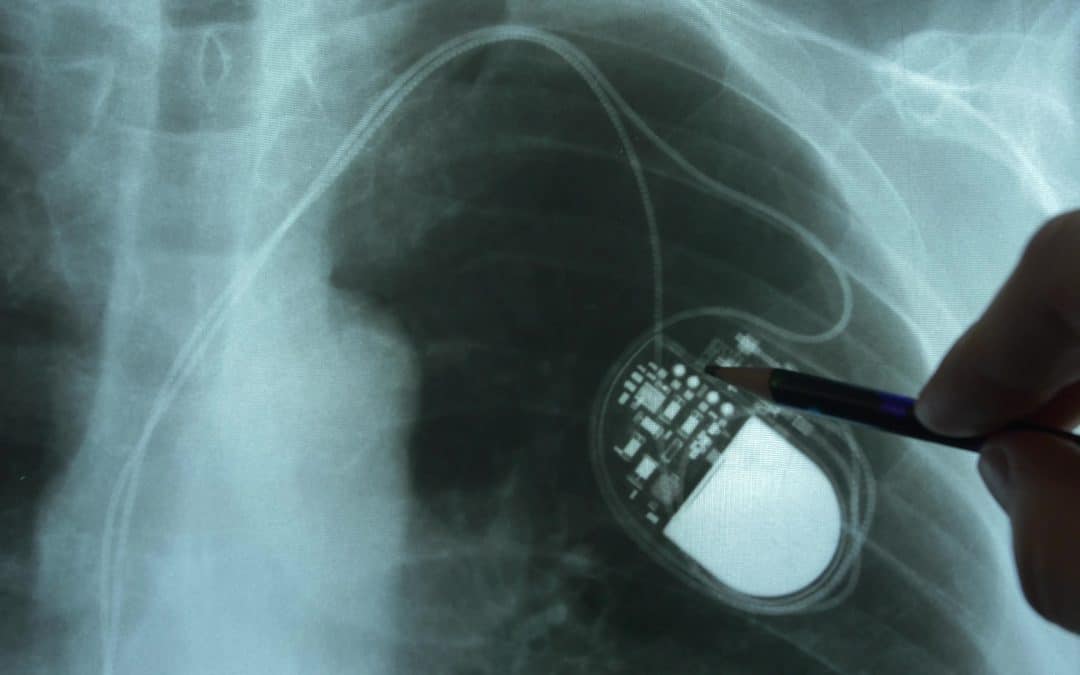EMFs stand for electromagnetic fields. As the name suggests, they are made up of both electric and magnetic fields. Anything that uses electricity will have electric charges moving through it in a circuit. Because of the charges, the circuit will also be surrounded by an electric field. Magnetic fields come from electric charges that are moving, so electronic circuits also have a magnetic field surrounding them. More energetic types of EMF are usually collectively referred to as the electromagnetic spectrum. This spectrum includes radio waves, microwaves, infrared light, visible light, ultraviolet light, x-rays, and gamma rays.
There are many sources of EMFs in our everyday lives. All electronics and devices plugged in to the power grid will emit power-frequency EMF, which oscillates at 60 Hz in North America and falls under the category of extremely low frequency EMF. The power grid itself, with high-voltage wires and transmission towers, also emits power-frequency EMF. But for most people, the largest exposure to power-frequency EMFs still comes from home and office devices and the wiring in the building that powers them. Electronics that communicate wirelessly do so by emitting radio frequency EMF. These oscillate at a much higher frequency than 60 Hz and include things like wireless mice and keyboards, WiFi routers, smart meters, cell phone towers and cell phones.
EMFs can interact with matter in our environment. They can affect the charged particles that are moving inside of a circuit, possibly affecting the function of the circuit. They can affect the charged particles within a human body, potentially leading to biological effects. The more energetic types of EMFs (i.e., x-rays, gamma rays, and some UV light) can cause more impactful changes to matter and are called ionizing radiation. Ionizing radiation is recognized as carcinogenic by the International Agency for Research on Cancer (IARC, 2000).
Less energetic forms of EMF are also capable of having an impact on humans, but not in the same way. At lower frequencies of EMF, such as frequencies related to the power grid, strong enough EMFs can stimulate nerve tissue near the surface of our bodies. This can lead to faint flickering of light in the outer edge of vision, a tingling sensation, and/or potentially discomfort and pain with more intense fields (ICNIRP, 2010). At higher frequencies such as radio frequency, strong enough EMFs can cause tissue heating effects (Health Canada, 2015).
Most sources of EMFs radiate outward in every direction and drop off in intensity very quickly with distance. Certain types of EMF can be shielded against. A metal mesh or sheath can form an effective shield against electric fields, and sensitive electronics may be designed with built-in shielding to protect it from external electric fields. Such shielding is called a Faraday cage. Magnetic fields are not as effectively shielded, but a conductive layer will decrease the intensity of the magnetic field somewhat.
Human exposure to EMF is restricted in certain cases. Ionizing EMFs are restricted federally and provincially depending on their sources and how they are used. Some non-ionizing EMF falls under the scope of Safety Code 6 published by Health Canada. Safety Code 6 is specific to EMF in the radio frequency (i.e., 3 kHz–300 GHz) and does not cover power-frequency EMF (i.e., 60 Hz) (Health Canada, 2015). Canada does not have federal or provincial regulations or guidelines on exposure to lower frequency EMFs. There are, however, international guidelines on limiting exposure to 60 Hz EMFs from several scientific and professional organizations. For professional organizations, the ACIGH (American Conference of Industrial and Governmental Hygienists) and the IEEE (Institute of Electrical and Electronics Engineers) have published guidelines (ACIGH, 2023; IEEE, 2019), and for scientific organizations, the ICNIRP (International Committee on Non-Ionizing Radiation Protection) has as well (ICNIRP, 2010).
Even though studies on EMF as a cause of cancer are inconclusive, due to a possible association between EMFs and cancer, certain Canadian jurisdictions have implemented local guidelines and limits regarding EMF exposure that are hundreds of times more stringent than the international guidelines. The City of Toronto, for example, has in place a policy of prudent avoidance regarding power-frequency magnetic fields near and in hydro corridors as well as the siting of cellular towers to reduce EMF exposure to citizens (City of Toronto, 2007; City of Toronto, 2008).
There is a wide variety of implanted medical devices, ranging from replacement eye lenses to implantable defibrillators. Some of these are metallic, and some are electronic and contain circuitry. These features are usually essential to their function, but they also affect how such devices respond to EMFs. The negative effect of EMF on implanted medical devices is also called electromagnetic interference, while the ability of these devices to withstand EMFs is called electromagnetic compatibility.
Metallic devices inside the body are more able to absorb energy from EMFs compared to human tissue. This effect is typically accounted for in the international guidelines. Electronic devices are much more sensitive to electromagnetic interference. Interference from EMFs can cause a variety of effects in the circuitry that enables the function of these devices. At the lowest severity, the interference could cause a harmless temporary malfunction that the device corrects automatically. Greater interference from a stronger field or on more sensitive electronics could cause the devices to not function, such as a pacemaker not pacing. Even greater interference could cause the devices to function improperly, such as a defibrillator delivering a shock when it was not necessary. As seen from these examples, because these devices serve medical functions, electromagnetic interference can have a variety of impacts ranging from no noticeable impact to a life-threatening impact.
The ACGIH and the IEEE have specific guidelines on exposure to EMFs when a worker is wearing a pacemaker or similar implanted medical device. The manufacturers of each device will also have done some amount of testing to verify electromagnetic compatibility. The user manual or technical manual for an implanted device should have this type of information in it. If you have such an implanted device, you can also ask your primary care physician who may be able to help interpret the manuals. Devices vary greatly in their sensitivity to EMFs. Sometimes, even devices from the same manufacturer can have wide variations in what they are able to tolerate.
Recognizing the variability requires each individual to talk to their doctor about their own medical device limitations, we are still able to provide some general advice regarding EMF exposure for implanted medical devices:
- Avoid intense EMF sources, such as but not limited to standing close to power-generating equipment, arc welding equipment, or jumper cables when in use.
- Inform your healthcare team of the device if you are having a medical procedure involving strong electric, magnetic, or electromagnetic fields, such as but not limited to using TENS equipment, having an MRI, or receiving diatherapy.
- Educate yourself and the people around you.
- Because the intensity of EMFs decreases very quickly with distance, an extra 10 cm distance from the source of EMF is often enough to decrease the intensity to background levels, but again this depends on the strength of the source and sensitivity of the implanted device
- Workplaces that have particularly elevated levels of EMF, such as power generation stations, will often measure their levels and post signage regarding EMF exposure or magnetic field exposure and post warning signs for people wearing implanted medical devices. Pay attention to these signs.
The effect of EMFs on implanted medical devices is real, potentially severe, and not easily predicted. Effects can range from harmless to life threatening and getting the device back to normal function can be automatic or require serious medical intervention. As society becomes more connected, novel forms of interference can arise. These issues are investigated by industrial hygienists, public health organizations, designers and manufacturers of devices, physicians, and many other people who use or know someone who uses such devices. If you have an implanted medical device, talk to your health care professional and check manufacturer’s documentation for specific precautions to avoid having a potential issue.
For more information on the topic of EMFs and implantable medical devices, please see our June 21, 2024 webinar and associated materials.
References:
“Ionizing Radiation, Part 1: X- and Gamma (γ)-Radiation, and Neutrons.” IARC Monographs on the Evaluation of Carcinogenic Risks to Humans, volume 75. IARC, 2000.
“ICNIRP Guidelines for Limiting Exposure to Time-varying Electric and Magnetic Fields (1 Hz–100 kHz).” Health Physics, 99(6):818‐836; 2010. ICNIRP, 2010.
“Safety Code 6 – Limits of Human Exposure to Radiofrequency Electromagnetic Energy in the Frequency Range from 3 kHz to 300 GHz.” Health Canada Safety Codes. Health Canada, 2015.
“Non-ionizing Radiation, Part 1: Static and Extremely Low-frequency (ELF) Electric and Magnetic Fields.” IARC Monographs on the Evaluation of Carcinogenic Risks to Humans, volume 80. IARC, 2002.
“Non-ionizing Radiation, Part 2: Radiofrequency Electromagnetic Fields.” IARC Monographs on the Evaluation of Carcinogenic Risks to Humans, volume 102. IARC, 2013.
2023 TLVs and BEIs. ACGIH, Cincinnati, Ohio, 2023.
“IEEE Standard for Safety Levels with Respect to Human Exposure to Electric, Magnetic, and Electromagnetic Fields, 0 Hz to 300 GHz.” IEEE Std C95.1-2019 (Revision of IEEE Std C95.1-2005/ Incorporates IEEE Std C95.1-2019/Cor 1-2019). IEEE, 2019.
“Protecting the Public from Exposure to Radiofrequency from Cell Towers.” Toronto Public Health, Backgrounder. City of Toronto, December, 2007.
“Reducing Electromagnetic Field Exposure from Hydro Corridors.” Toronto Board of Health, Staff Report. City of Toronto, June 18, 2008.







